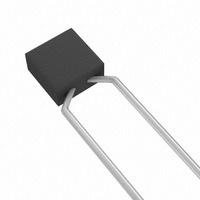M39014/01-1553 Kemet, M39014/01-1553 Datasheet - Page 2

M39014/01-1553
Manufacturer Part Number
M39014/01-1553
Description
CAP CER .1UF 50V 10% RADIAL
Manufacturer
Kemet
Series
Military, MIL-PRF-39014, CKR05r
Specifications of M39014/01-1553
Capacitance
0.1µF
Voltage - Rated
50V
Tolerance
±10%
Temperature Coefficient
X7R
Mounting Type
Through Hole
Operating Temperature
-55°C ~ 125°C
Applications
General Purpose
Ratings
-
Package / Case
Radial
Size / Dimension
0.190" L x 0.090" W (4.83mm x 2.29mm)
Height - Seated (max)
0.200" (5.08mm)
Thickness (max)
-
Lead Spacing
0.200" (5.08mm)
Features
Military
Lead Style
Flat Bent
Lead Free Status / Rohs Status
Contains lead / RoHS non-compliant
Other names
C052T104K5X5CR
CKR05BX104KR
M39014/01-1553
CKR05BX104KR
M39014/01-1553
ceramic capacitors are as follows:
and may be used with DC voltage applied in either direction.
tinuous DC working voltage permissible across the entire
operating temperature range. Multilayer ceramic capacitors
are not extremely sensitive to voltage, and brief applications
of voltage above rated will not result in immediate failure.
However, reliability will be reduced by exposure to sustained
voltages above rated.
farad. For practical capacitors, it is usually expressed in
microfarads (10
(10
follows:
capacitors also have resistance and inductance. A simplified
schematic for the equivalent circuit is shown in Figure 1.
Other significant electrical characteristics resulting from
these additional properties are as follows:
mally very high, the total impedance of the capacitor is:
C = Capacitance
Class I (up to 1,000 pF):
Class I (over 1,000 pF):
Class II:
Class III:
L = Inductance
-12
Where
The fundamental electrical properties of multilayer
Polarity: Multilayer ceramic capacitors are not polar,
Rated Voltage: This term refers to the maximum con-
Capacitance: The standard unit of capacitance is the
Like all other practical capacitors, multilayer ceramic
Impedance: Since the parallel resistance (Rp) is nor-
farad). Standard measurement conditions are as
Z =
L
ELECTRICAL CHARACTERISTICS
Figure 1
-6
Z = Total Impedance
RS = Equivalent Series Resistance
X
X
© KEMET Electronics Corporation, P.O. Box 5928, Greenville, S.C. 29606, (864) 963-6300
farad), nanofarads (10
C
L
R
= Inductive Reactance = 2 fL
= Capacitive Reactance =
S
2
R
R
R
+ (X
S
S
P
= Equivalent Series Resistance (ESR)
= Insulation Resistance (IR)
C
- X
maximum.
maximum.
1 kHz and 1.0 ± 0.2 VRMS.
1 kHz and 0.5 ± 0.1 VRMS.
1MHz and 1.2 VRMS
1kHz and 1.2 VRMS
L
)
APPLICATION NOTES FOR MULTILAYER
2
-9
farad), or picofarads
R
C
P
CERAMIC CAPACITORS
2 fC
1
determines its effectiveness in many applications.
sure of the losses in a capacitor under AC application. It is the
ratio of the equivalent series resistance to the capacitive reac-
tance, and is usually expressed in percent. It is usually mea-
sured simultaneously with capacitance, and under the same
conditions. The vector diagram in Figure 2 illustrates the rela-
tionship between DF, ESR, and impedance. The reciprocal of
the dissipation factor is called the “Q”, or quality factor. For
convenience, the “Q” factor is often used for very low values
of dissipation factor. DF is sometimes called the “loss tangent”
or “tangent ”, as derived from this diagram.
DC resistance measured across the terminals of a capacitor,
represented by the parallel resistance (Rp) shown in Figure 1.
For a given dielectric type, electrode area increases with
capacitance, resulting in a decrease in the insulation resis-
tance. Consequently, insulation resistance is usually specified
as the “RC” (IR x C) product, in terms of ohm-farads or
megohm-microfarads. The insulation resistance for a specific
capacitance value is determined by dividing this product by
the capacitance. However, as the nominal capacitance values
become small, the insulation resistance calculated from the
RC product reaches values which are impractical.
Consequently, IR specifications usually include both a mini-
mum RC product and a maximum limit on the IR calculated
from that value. For example, a typical IR specification might
read “1,000 megohm-microfarads or 100 gigohms, whichever
is less.”
resist the flow of DC leakage current. It is sometimes referred
to as “leakage resistance.” The DC leakage current may be
calculated by dividing the applied voltage by the insulation
resistance (Ohm’s Law).
ing voltage (DWV) is the peak voltage which a capacitor is
designed to withstand for short periods of time without dam-
age. All KEMET multilayer ceramic capacitors will withstand a
test voltage of 2.5 x the rated voltage for 60 seconds.
standard measurement conditions are shown in Table 1 on
page 4. Variations in these properties caused by changing
conditions of temperature, voltage, frequency, and time are
covered in the following sections.
The variation of a capacitor’s impedance with frequency
Dissipation Factor: Dissipation Factor (DF) is a mea-
Insulation Resistance: Insulation Resistance (IR) is the
Insulation Resistance is the measure of a capacitor to
Dielectric Withstanding Voltage: Dielectric withstand-
KEMET specification limits for these characteristics at
DF = ESR
X c
=
Figure 2
2 fC
X c
1
X
c
ESR
O
5















